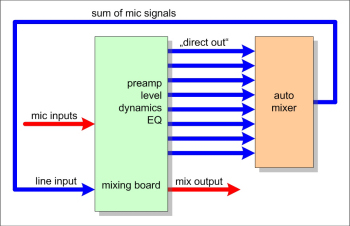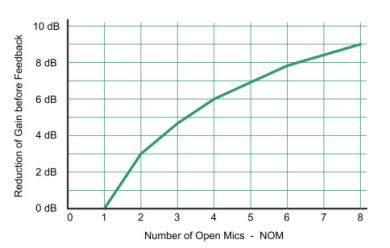
reduction of gain before feedback for open microphones
In 1971 Dan Dugan developed the first automatic microphone mixing systems (after several years of work): a patented system he called the "Dugan Music System" and the patented "Dugan Speech System". Later Dan Dugan licensed his patents to the Altec Lansing Corporation. Altec produced five or six different devices that worked finally well. In 1993 the patent expired and Dan Dugan started a new product line.
Dan Dugan Sound Design holds three patents: the Dugan Speech System, which automatically manages any number of live microphones in unscripted talking situations; the Dugan Music System, which offers automatic downward expansion to help reduce feedback and noise pick-up in live performance venues, and the Dugan Gain Limiting System, which provides a continuous NOM (number of open mics) master gain adjusting system to prevent feedback and ambient noise build-up.
Dan Dugen: "I was designing sound for the regional companies of Hair in 1968. The shows had one person working rotary knobs for 16 area mics, 9 hand mics, and 10 mics in the band. I got the idea that a microphone shouldn't be on unless it's getting something more than the room ambience." After several years of experimenting, Dugan came out with
Every doubling of open microphones in a sound reinforcement system diminishes the gain before feedback by 3 dB because the sound energy increases by 3 dB (the transmitted energy of two sound sources with non-correlated signal compared to only one sound source is an increase of 3 dB).
The basic idea behind automatic microphone mixing is to keep used microphone inputs open and to close or attenuate unused channels. Using two or more channels at the same time, each channel must be attenuated to keep a stable gain before feedback. Each doubling of open microphones decreases the gain before feedback by 3 dB.
The number of open microphones is called NOM. The NOM count in an automatic mixing system represents the number of open microphones. The NOM is the parameter that determines how much gain reduction is necessary.

There are slightly different operating principles. One was developed by IRP: the automatic microphone mixer uses Dynamic Threshold Sensing (DTS) to differentiate between active and inactive microphones. DTS generates a threshold reference which starts at high levels and scans over an 80dB range to low levels. All microphone input channels are compared to the threshold reference simultaneously. This search takes 10 milliseconds or less. When the DTS sensor determines the first channel that exceeds the threshold reference level, that channel is given ON status. The microphone is rapidly turned ON when activated, preventing cutting of leading audio signals. Simultaneously the threshold reference is reset high and another scan is started. When a channel is given ON status, an individual timing cycle is initiated, maintaining the channels ON status for a preset period of time. On a repeated scan, the same or a different channel may exceed the threshold reference level, receive ON status and have its timing cycle effectively updated without dropouts. Rather than turning an inactive microphone OFF, it is attenuated by an internally preset -15dB or -30dB. A continuous count of the number of ON microphones is used to adjust the master amplifier gain according to the rule of reducing gain by 3dB for each doubling of the number of simultaneously active microphones.
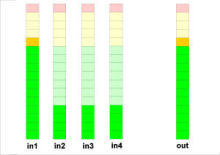 |
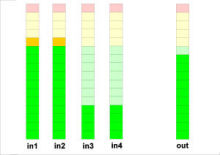 |
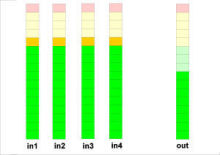 |
| one open mic > full level | two open mics > - 3 dB | four open mics > - 6 dB |
In live sound and broadcast applications (talk shows, interviews with many participants etc.) just an automatic microphone mixer can not deliver the necessary results. A often used and very well working arrangement is an auto mixer set-up as a loop-in in conjuction with the regular mixing board. All mic channels are treated as usual but fed into the auto mixer via the direct out outputs (setting: post fader!). Now the sum output of the auto mixer is fed back into the mixing board via one single input channel. All the necessary adjustments for the individual mic input channels will be done on the mixing board, just the handling of the often rapid change-over between 'open' and 'closed' mics originated by fast talking and interrupting persons is handled (un-audibly) by the auto mixer.
